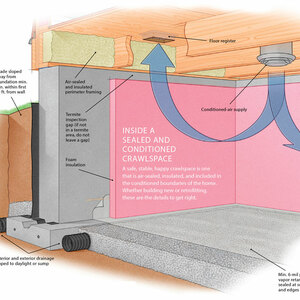I am starting to redo the third floor of my home–now empty attic space under a pitched roof. The rafters are only 4′ 3/4″ deep, so I need to “fir” them with 2″ by 3″s so that I can fit baffle and insulation. I have a couple questions:
1.) What R-rating of insulation should I use–I’m in CT.
2.) The rafters are not flush with one another–some hang a fraction of an inch lower than others. What are the tricks to making them flush so that when I hang drywall it isn’t all wavy and buckled?
Luke


















Replies
Welcome to BT. I'm just doing a project just like this - I'm taking some time deciding the best way to handle the rafter issue -
http://forums.taunton.com/tp-breaktime/messages?msg=84041.90
Forrest
Yes you need to fir down the rafters - quite a bit. Here in NC we use R-30, but in CT I'd suspect that R-38 would be the minimum. If you are going to use fiberglass insulation they sell R-38C batts that require about 11" if you are going to leave ventilation channels above the insulation. That would cut down on your head room quite a bit. Really though, you may want to check into using another kind of insulation. Sprayed in foam, for example, may be able to give what you need in as little as 6" although it will be significantly more expensive. Spray foam is normally contractor installed - the whole process is not that DIY friendly.
I use a system of 2x3's and plywood gussets that are stapled to the sides of the rafters to build down the rafters to the desired depth. On the present house we are building I have 2x8 rafters and gussets that are 16" long by 4" wide. The gussets are fastened to the 2x3's and then butted up to the roof sheathing and stapled. There is a loss of headroom but there is plenty of room for insulation. We use blown-in cellulose.
you don't give alot of info...
but lets first assume you have plenty of head room... and need to have 12" of space for your baffle and insulation... I'd rip some 7/16 osb to 9.6 inches so that i'd get 5 8ft strips per sheet... I'd fasten a 2x2 or a ripped in half 2x4 (whichever was cheaper) to the 8ft edge that would face the finished room...the other long side would be nailed to the side of you existing rafter at the desired depth... setting the ones at each end of the room and pulling a string so that they all fall in plane... you can of course adjust how wide the rip the osb to get the depth you need... you can even change the pitch of the interior ceiling if you like... by cutting them wedge shaped... pretty easy to build up a stack and install...
p
I don't know how much insulation you need. But I've never heard anyone say: "I wish I hadn't put in so much insulation".
It's a lot easier to do it right the first time than to add more later.
Couple ways to attack it.
Is the roof vented currently? (Ridge and soffet vents?)
If so, you'll need to install the baffles first. If not vented, you don't need them.
My prefered method would be to fir the rafters with 2X running perpendicular. Shim them as necessary to keep a flat plane. Then have the insulation sprayed.
This will be considerably more expensive as you'll need to hire the insulation out.
If that's not in the buget, you could use unfaced batts to fill between rafters prior to firring.....then use ridgid insul board to fill between the firring strips.
Neither will give you optimum R-value....but without sacrificing some serious headroom, its the best you can do.
J. D. REYNOLDS
Home Improvements
I'm in the midst of renovating a transitional Victorian in Nashville for myself and my girlfriend, so I'm investigating options on our project in hopes that I can later recommend them to my clients. Our house has very randomly spaced rafters and limited headroom, so I'm planning to use either icynene or sprayed polyurethane. They are relatively identical in price based on a couple estimates I've gotten. Neither needs ventilation above it and both claim to have much better performance than fiberglass in terms of air infiltration. Since they're sprayed in, they fit each cavity perfectly and fill all voids. The polyurethane has double the R-value per inch than icynene or fiberglass, and around here, installers only spray it to a depth of 2- 2 1/2" on roofs. That gives it an R-value of R-14 to R-17, but because it leaves no voids, is a virtually complete air barrier, and has better thermal resistance through a much greater temperature range than fiberglass, the polyurethane installers with whom I've spoken claim it to have an effective R-value of R-50. Sorry if I sound like a salesman, but I suppose I'm still convincing myself it's worth the money. I'm actually still investigating it and trying to find some good neutral assessment of insulation options. As a frame of reference in terms of price, the estimates I've gotten for both icynene and poly have amounted to basically $2.25 per square foot. Often they prefer to spray the entire roof deck, not just the living space, so keep that in mind. Also, remember that more living space means more heating and cooling capacity. If your current hvac system is a little oversized, and they often are, you may not need to upsize it with sprayed foam. We'll need a completely new system in our house, so I may end up saving $3,000 to $4,000 just in the downsizing of the hvac we'll need if using spray vs. fiberglass or cellulose.
I hope this helps. Feel free to ask more.
Thanks for all of the suggestions; I'm certainly open to more thoughts. I will update once I have made a little progress on this.
Luke
furring, not firring